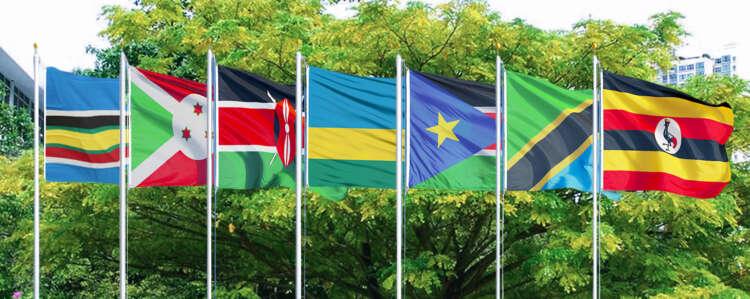- AmCham Summit kicks off, setting course for robust future of US-East Africa trade ties
- Why the UN is raising the red flag on the UK-Rwanda asylum treaty
- Portugal’s Galp Energia projects 10 billion barrels in Namibia’s new oil find
- Wärtsilä Energy offers tips on how Africa can navigate energy transition and grid reliability
- Powering Africa: Africa’s Path to Universal Electricity Access
- Global investment trends at AIM Congress 2024: a spotlight on the keynote speakers
- South Africa’s deepening investment ties in South Sudan oil industry
- Agribusiness could drive Africa’s economic prosperity
Browsing: Doing business in East Africa
Regional business umbrella body has called for harmonization of COVID-19 charges to boost intra EAC trade.
The East African Business Council (EABC) has said that in a bid to ease the cost of doing business and boost intra-EAC trade emerging costs such as the COVID-19 related charges in the East African Community should be standardized. This is set to support businesses to be more resilient and rebound amidst the COVID-19 pandemic.
Also Read: Kenya’s president calls on African leaders to harmonise Covid protocols
This comes days after Kenya’s president Uhuru Kenyatta called on African leaders to harmonise COVID-19 protocols. According to the president, harmonising the protocols will determine whether the African Union (AU) meetings will be virtual or physical given the challenges occasioned by the COVID-19 pandemic.

Currently, COVID-19 tests are priced differently in each Partner State, while containment measures are varied. For instance, Tanzania …
A regional business umbrella body has called upon East Africa’s partner states to harmonise investment incentives and market the region as a single investment destination.
The East African Business Council (EABC) is counting on the six heads of EAC member states to merge marketing of the bloc and attract investors in the various opportunities available. One of the aspects the EABC recommends is harmonising incentives to make it easier for investors to pick the bloc from the rest of the continent.
East Africa has often been referred to as one of the fastest growing trading blocs in Africa. With a population of more than 177.2 million people the region presents a readily available demand for products and services that emerge from the prospective investments. The region also has a combined GDP size of more than US$147.5 billion.
A recent report by South Africa’s Rand Merchant Bank …
The East African region is a vast region with massive resources, population, and an established commercial landscape that presents viable business opportunities for external investors. According to statistics both by the World Bank and IMF, the region was one of the fastest-growing in Africa with a high influx of foreign direct investments.
In the 2019 report, United Nations Conference on Trade and Development (UNCTAD) noted that the East African region including Ethiopia received $9 Billion in foreign direct investment with projections of this figure doubling over time. However, the effects of the Covid-19 has had a great effect both on the economic growth as well as the number of foreign investments into the region.
The African Development Bank, in its analysis of the effects of Covid-19, highlighted the rebound of the East African economy as one of the main points of observation of the continent’s resilience. GDP growth for 2020 …
The continuous spread of the COVID-19 pandemic across the world means that people’s ability to access safe and nutritious diets is at risk, further leading to an even wider global health crisis of the century.
Coronavirus has disrupted production, transportation, storage and sale of food and food items. Consequently, hunger and malnutrition levels have increased considerably especially because of the virus, even though many were already struggling with these issues prior to the pandemic.
According to a 2019 report, The State of Food Security and Nutrition in the World, over the past three years, the number of those suffering world hunger has been growing, only reflecting levels that were recorded almost a decade ago.
Also Read: Desert locusts , if not contained pose a threat to EAC’s food security; FAO
The report concludes that: “Hunger is on the rise in almost all African sub–regions, making …
During the last decade much has been said about the urgency to develop the African agricultural sector to meet the increasing need for food security across the continent. Frequently it is stressed that Africa largely missed the “Green Revolution” since the continent’s agriculture sector did not transform into an intensive arena with modern technologies to increase the crop yield significantly1.
Until today the East African agricultural sector is dominated for 75% by smallholder farmers that apply low farming inputs, traditional technologies and methods, while agriculture remains the backbone of the economy2. This article discusses a reason for optimism, and how a circular economy (aims close the loop of resources through the establishment of restorative and regenerative systems), can contribute to food security and food productivity in East Africa.
Also Read: Food security: Opening markets for smallholder farmers
Africa missed the Green revolution; an opportunity to implement …
The East African Community (EAC) has spent twenty years of integration and admitted new members in the process. EAC Partner States signed the Protocol in November 2009, and it came into force on 1 July 2010. The common market is the first of its kind in Africa. The internal EAC market has about 146 million consumers.
This second offering, after the initial community collapsed in 1977 has worked to learn from the mistakes of the past community. However, as things change, the more they have remained the same.
There have been tensions between countries at different periods of time, some threatening the very core that set forth the community. Kenya has been at constant feud with Tanzania, Uganda has been also at loggerheads with Rwanda while Burundi has accused Rwanda of meddling in its affairs.
Overall trade disputes are now increasing in East Africa. Uganda’s trade …
The Ethiopian Investment Commission (EIC) announced that the country earned $103 million from export generated by industrial parks. The gain is a 40 percent increment compared to last year’s performance recorded at the same period.
According to Abebe Abebayehu, Ethiopia Investment Commissioner, 70 percent of the planned earning from industrial parks during the stated period had been accomplished. He further noted that footwear and other leather products, as well as textile and apparel have been exported to Europe, USA, Asia and other export destinations. Statistics from Food and Agricultural Organisation (FAO) ranks Ethiopia the 5th in the world and number one in Africa with the most cattle inventory.
Mr. Abebe, stating that industrial parks across the country have created employment for over 70,000 workers, said Ethiopia has been able to attract $2.5 billion foreign direct investment in the mentioned nine months.
However, the commissioner said, conflicts in different parts …
Human resource has been described as the most essential resource in an organization since it is the human aspect that makes sure that all other resources work optimally (or not).
In the construction industry, the concept of human resource management is not as well defined and improved as in other mainstream and formal industries.
For every industry to grow there has to be continuous improvement of efficiency in resources usage. There has to be capacity building to empower all the stakeholders to be better and to do better.
Every construction site has labour, whether mechanized systems are employed or not and also regardless of the magnitude of mechanization. This therefore makes it necessary to direct enough attention and resources towards human resource management and development in construction.
How many times have you commissioned a site and you only know the contractor out of an average of 20 craftsmen in your …
The total volume of Islamic Banking and Finance has been exceeded $2.6 trillion globally. The growth of the Islamic banking and finance volume in different continents and regions is continuous with the positive node but sometime its vary region to region.
Due to the reason, about 2,500+ Islamic banking and financial institutions are working in every region including both Muslims and non-Muslim countries. In the current era, Islamic banking and finance started in 1960s from Egypt and Malaysia and dramatically spread over the Middle East, Africa, Europe and other regions.
The growth of this phenomenon swiftly increased in Middle East, South and East Asia whereas, in some regions, the growth of the industry was comparatively slow as in Northern African (Tunis, Morocco, Algeria etc.), Central Asian and Balkan countries. But keeping in view the Islamic banking and finance industry initiative was taken very late in Commonwealth Independent States (CIS) countries …





